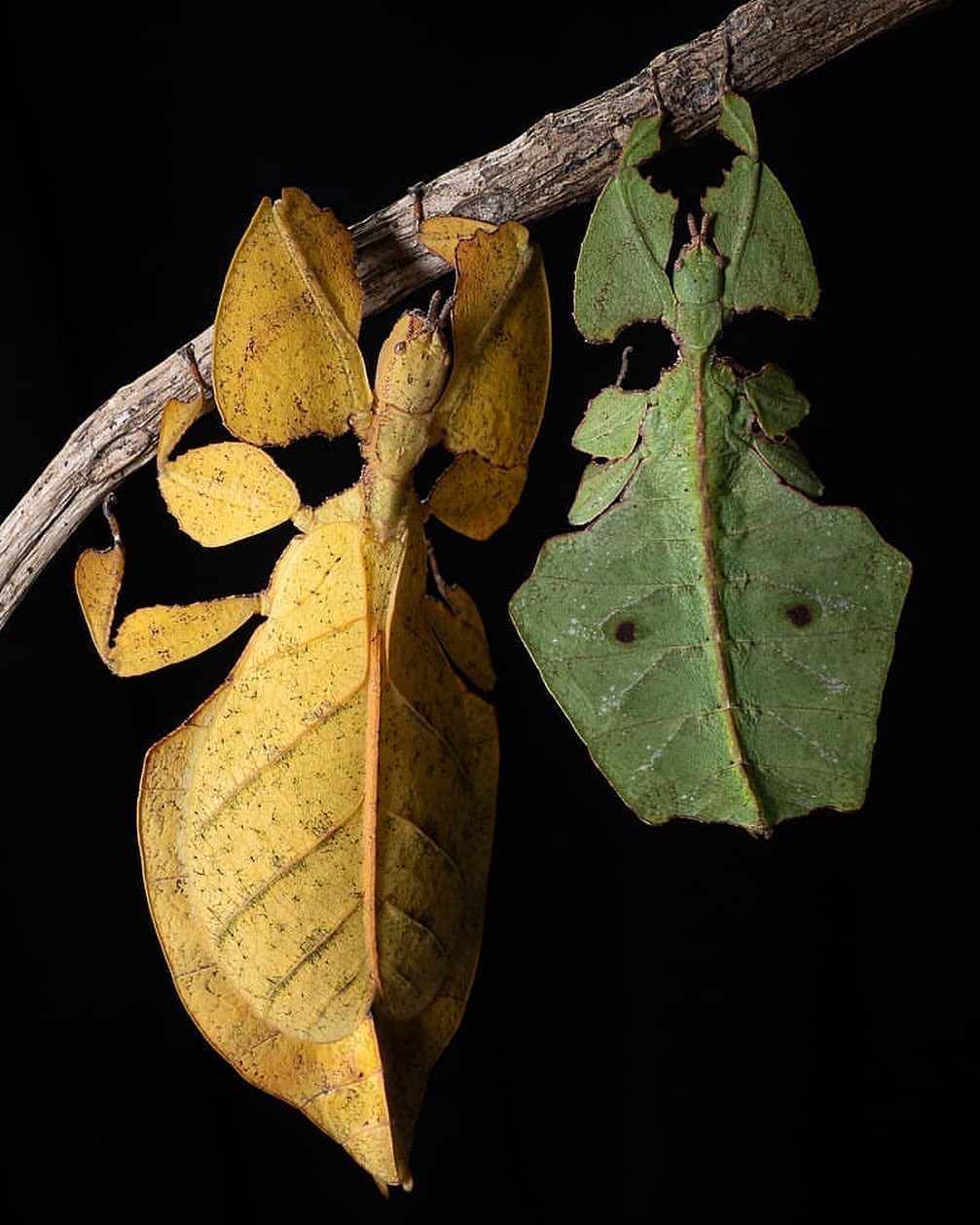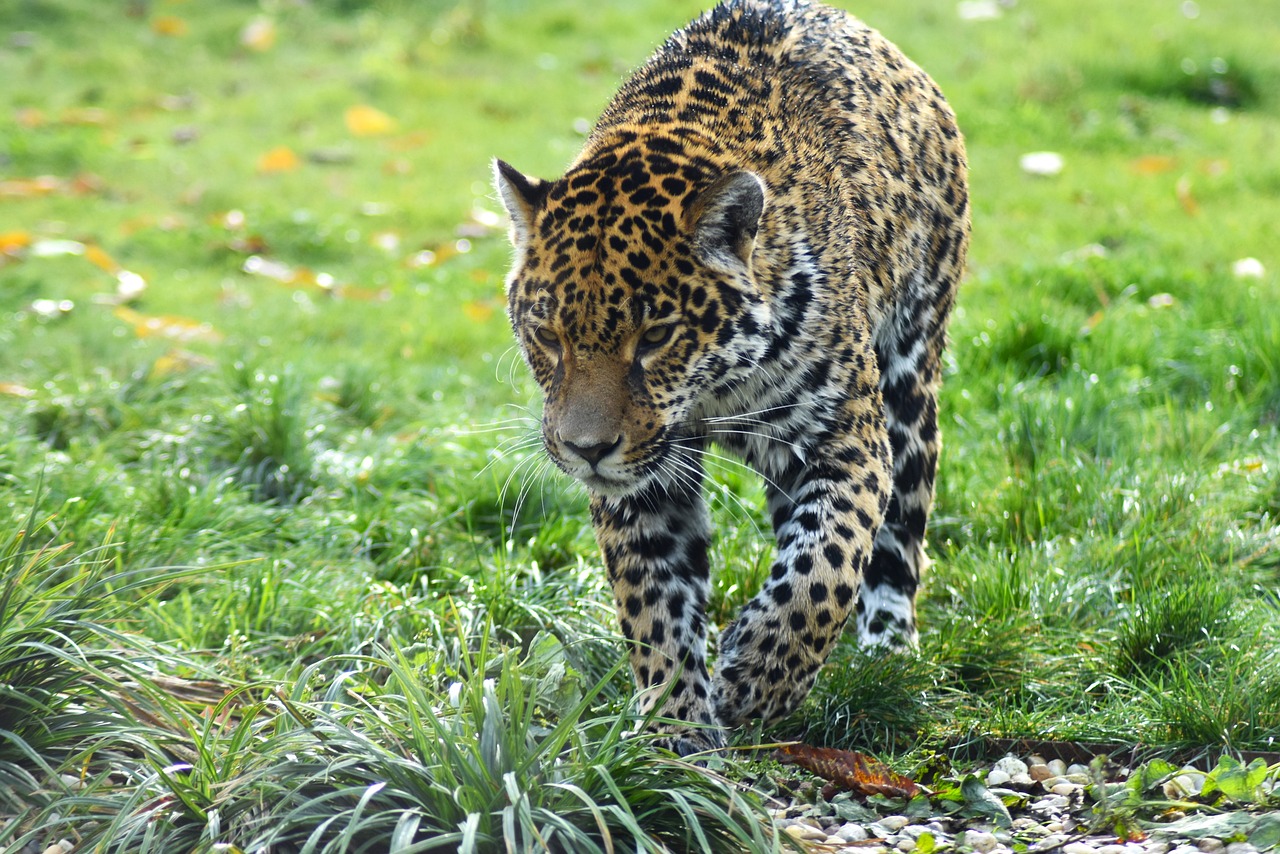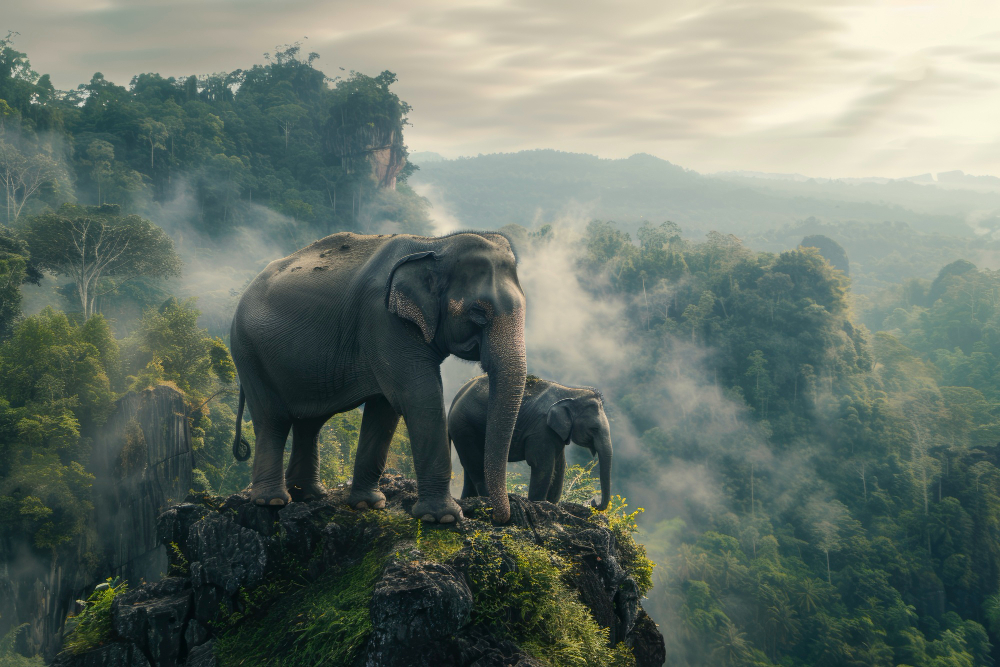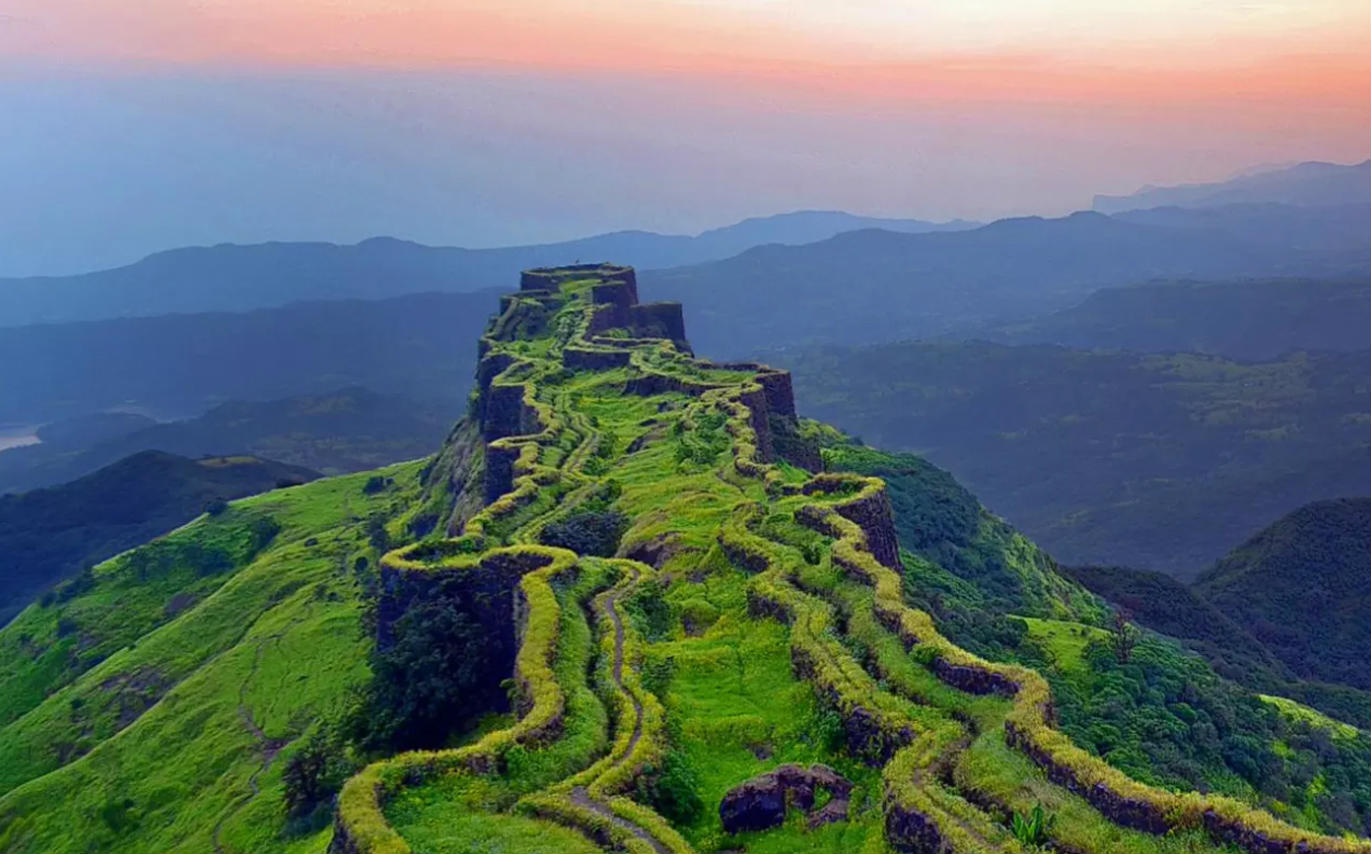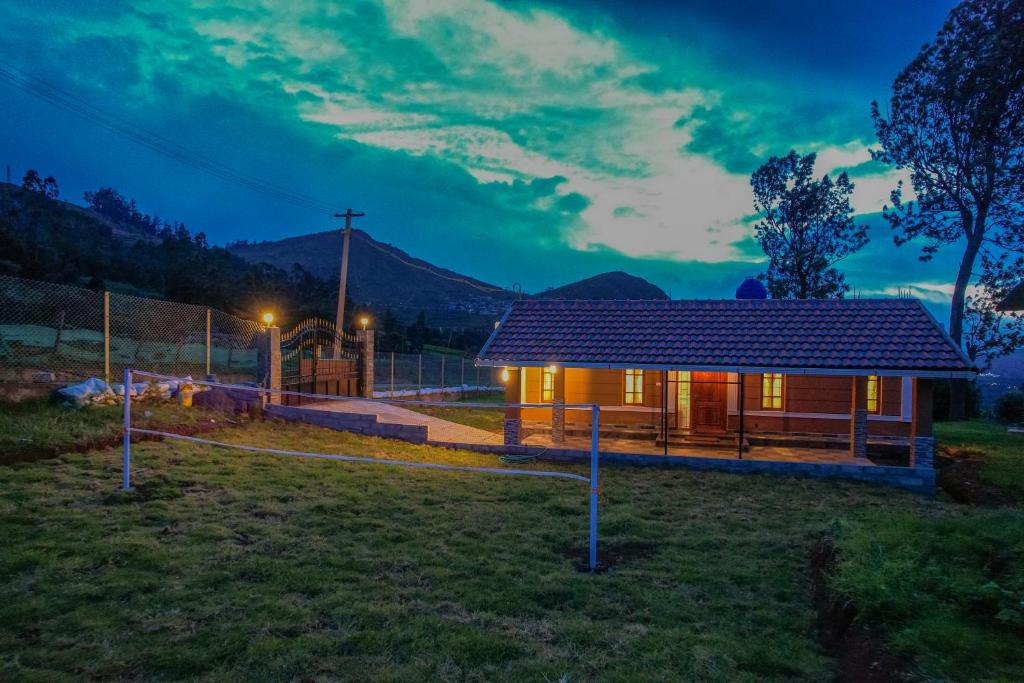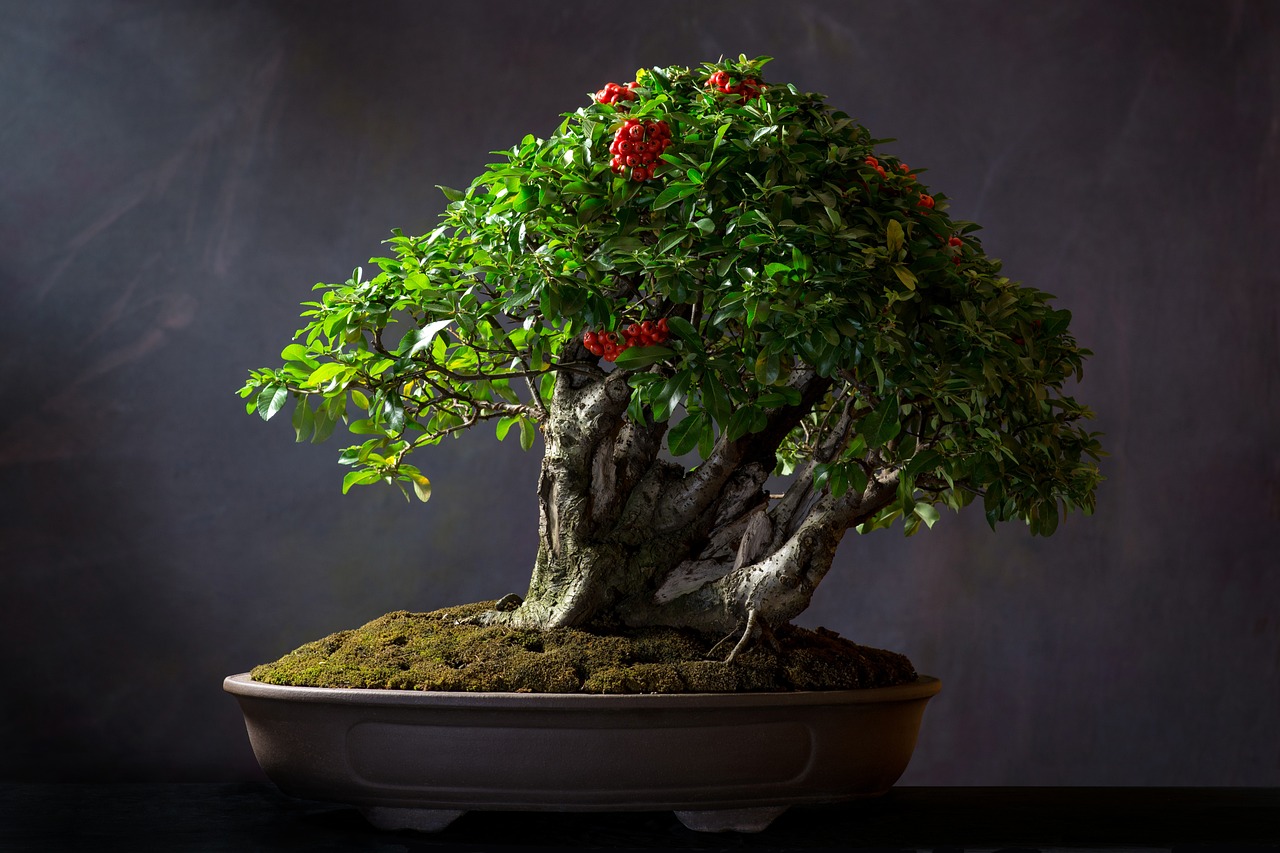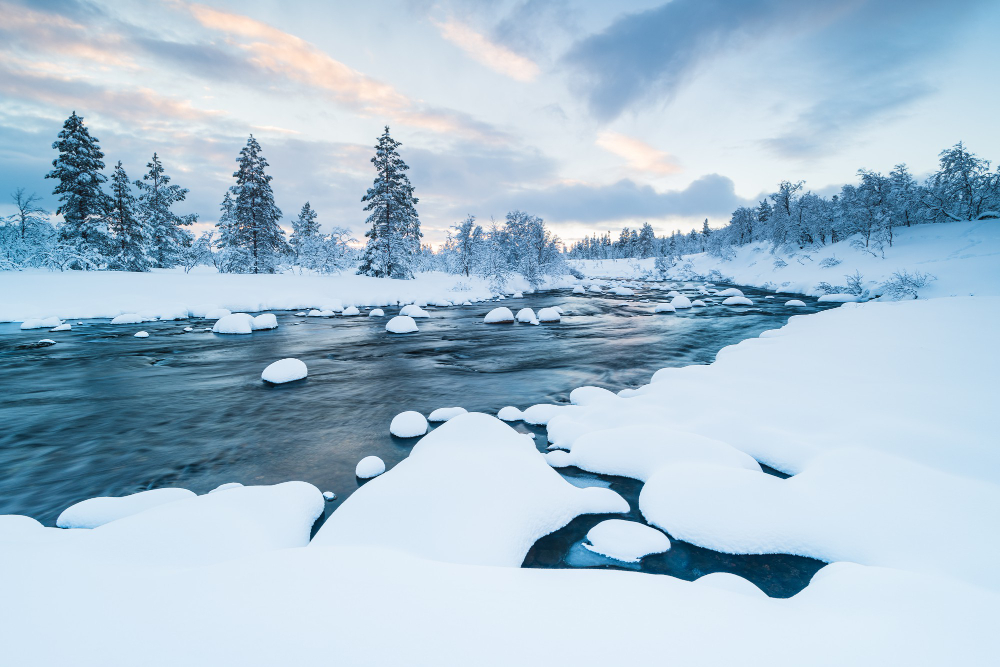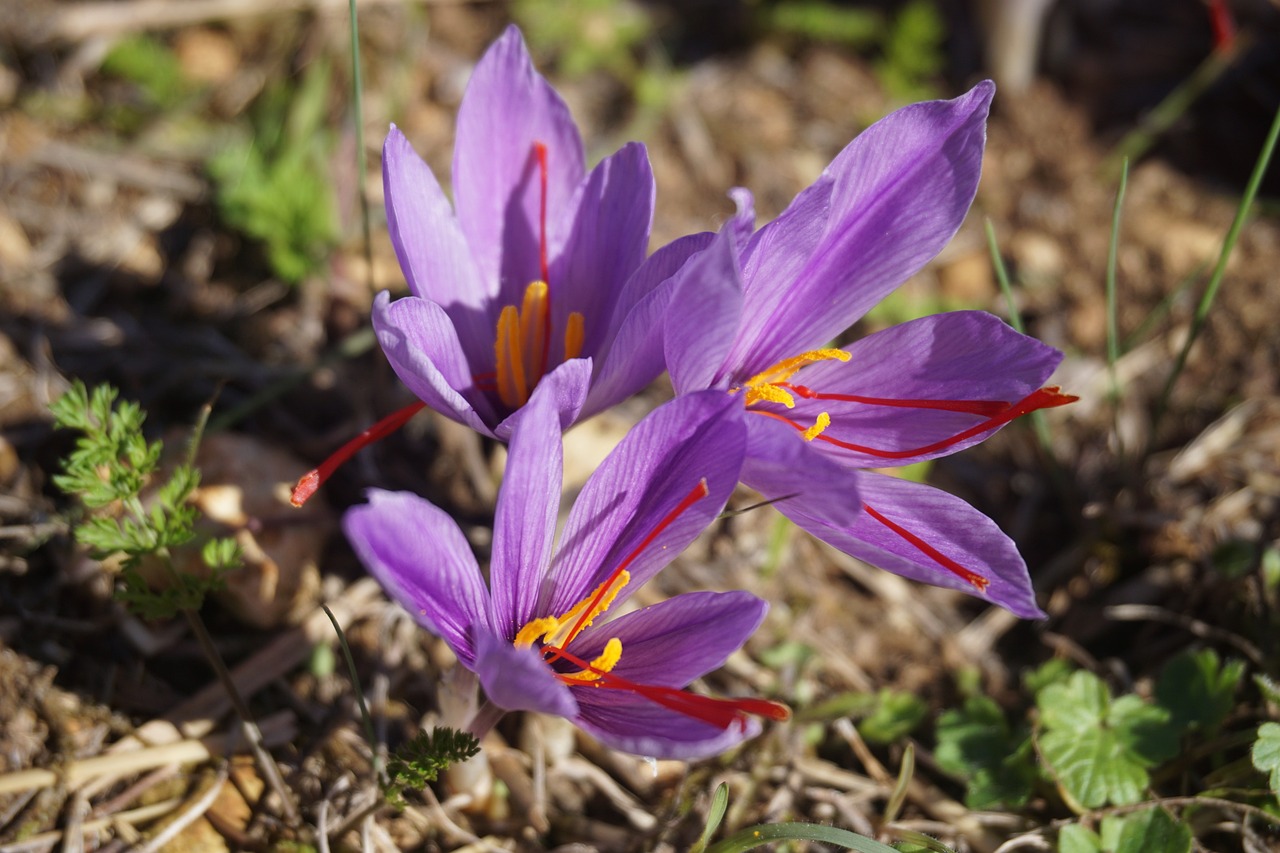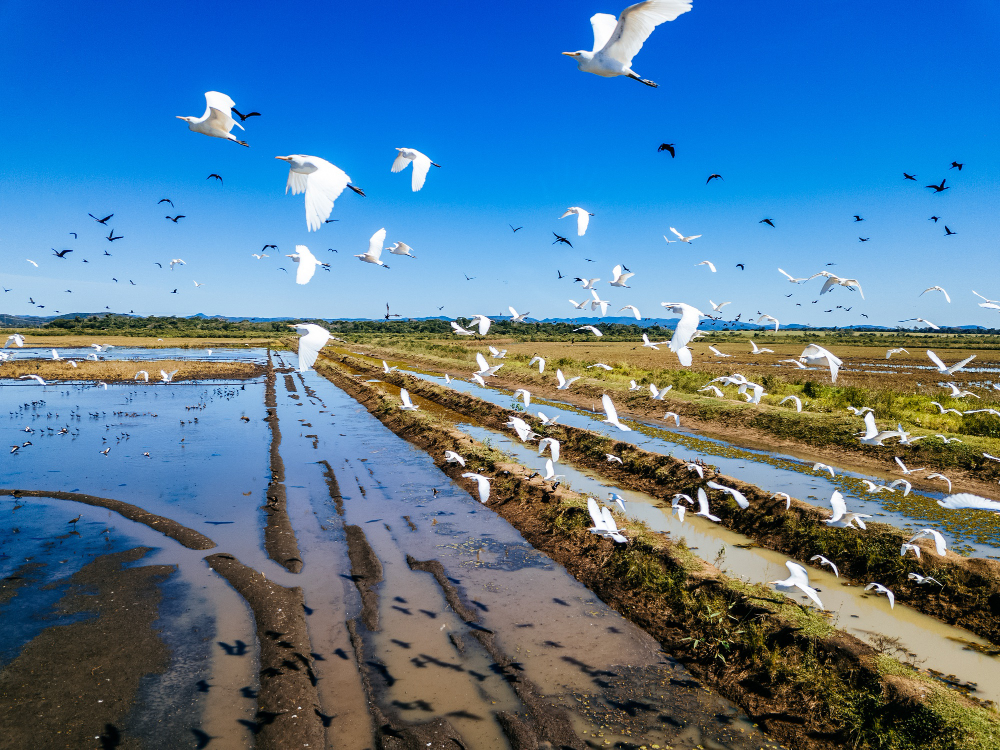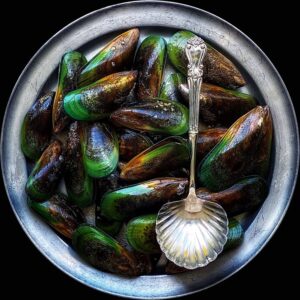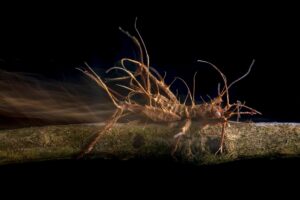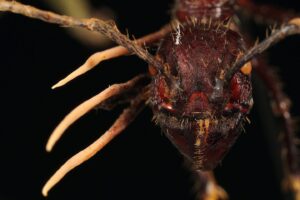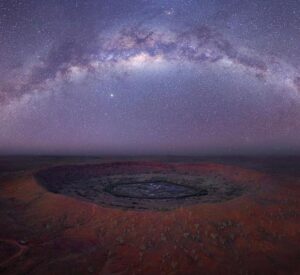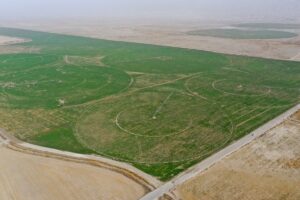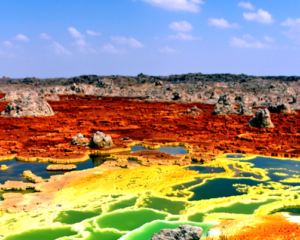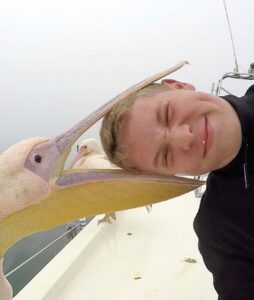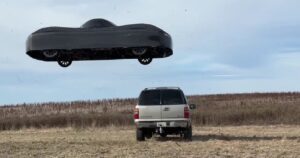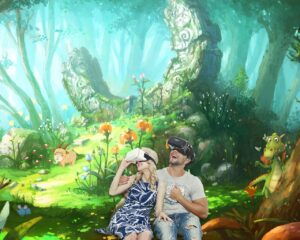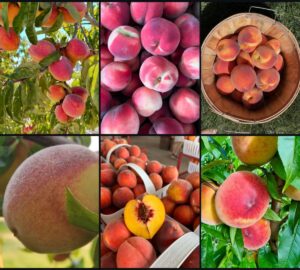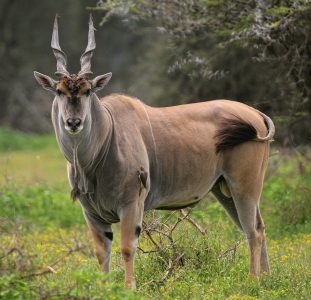 Pin
Pin Eland / Photo courtesy of Johns Spreitzer
There exists — upon the Sun-scorched Plains — a congregation of Beasts so vast in Form that one might pause — and reconsider — what we thought we knew of Grace. The Antelope — that word conjures something delicate — perhaps — a creature built of Wind and Morning Light. Yet some among them carry Weight — substantial as Philosophy — and stand as tall as human Aspiration.
The Earth — in her peculiar Wisdom — fashioned these Beings not as gentle Ornaments but living Monuments to Survival’s stern Demands. They move across the Grasslands with a Heaviness that speaks — not of burden — but of Purpose. Each step — a declaration — each breath — a small Eternity. To witness them is to understand that Magnitude need not abandon Beauty — that Power can wear Grace like a second skin — and that the largest Hearts may beat within the largest Frames.
Table of Contents
1. The Eland — Africa's Bovine Philosopher
 Pin
Pin Eland / Photo courtesy of Yves Strybos Photography
The Common Eland stands — as if in Meditation — at the Summit of our List. This creature — weighing near a Ton — moves through the Woodland with a Contradiction the Mind struggles to contain. How does such Mass achieve such Quietude? The Bulls — magnificent in their spiraled Horns — carry up to 2,000 pounds upon their Frames — yet trot with all the lightness of a Thought half-formed. Their coats — a tawny brown with subtle Stripes like Secrets whispered down their Sides — shimmer in the Heat as though they might — at any moment — dissolve into pure Light.
What strikes the Observer most is not their Size alone — but something in their Bearing — a kind of ancient Patience. They inhabit the Savannas and the Open Plains from Kenya down to South Africa — eating Leaves and Fruits — and asking nothing more of Life than what it freely gives. The Eland possesses a dewlap — that loose fold of Skin beneath the Throat — which swings like a Pendulum keeping Time with some internal Rhythm we cannot hear. To watch them is to witness Dignity — not learned — but inborn — as natural as Breathing — as inevitable as Dusk.
2. The Giant Eland — Where Magnitude Meets Myth
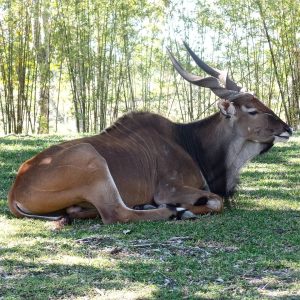 Pin
Pin Giant Eland / Photo courtesy of Zoo Footage
The Giant Eland — cousin to the Common — surpasses even that impressive Beast in Scale and Splendor. This is the largest Antelope that walks the Earth — a fact that seems almost implausible until one stands before it. The Bulls achieve weights of 2,200 pounds — sometimes more — and their Shoulders rise six feet from the Ground. They inhabit the Central African Woodlands — places where the Trees grow thick and the Shadows hold their Secrets close. Their Horns spiral upward in elegant Twists — each Ridge a Year of Life recorded — each Curve a Testament to Time’s patient Sculpture.
What distinguishes the Giant Eland beyond mere Measurement is the vertical white Striping that adorns their russet Sides — ten to fifteen Lines that run like Latitude across a living Map. These Stripes serve Purpose — breaking up their Outline in the dappled Forest Light — turning something enormous into something nearly invisible. They move through Cameroon and the Central African Republic with a Quietness that defies Logic — how does something so immense become so unobtrusive? The Cows — though smaller — possess their own considerable Presence — and the Herds maintain Hierarchies complex as any human Society. To encounter one is rare — a Privilege granted to few — a moment when the World reveals it still contains Wonders we have barely begun to comprehend.
3. The Bongo — A Forest Spirit in Corporeal Form
 Pin
Pin Bongo / Image by Pexels
The Bongo appears — at first glance — as though someone painted Sunset onto a living Canvas and set it wandering through the Rainforest. This Antelope — the third largest — carries between 500 and 900 pounds depending on whether we speak of Cow or Bull. But Numbers fail to capture what the Bongo truly is. Its coat burns a deep chestnut red — so vivid against the green Twilight of the Forest Floor that one might think it a Flame that forgot to consume. Across this crimson Background run twelve to fourteen vertical white Stripes — each one precise as though drawn by some celestial Hand with a Ruler and infinite Patience.
The Bongo dwells exclusively in the dense Mountain Forests of Central Africa — a Place where Sunlight arrives in Fragments and the Air hangs heavy with Moisture and the breath of growing Things. Both Males and Females carry Horns — a rarity among Antelope — spiraling upward and slightly back in elegant Lyre shapes. These Horns can reach three feet in length — and the Bongo has learned to tilt its Head back while running — laying the Horns along its Spine — to slip through tangled Undergrowth without becoming ensnared. Such Adaptation speaks to Intelligence — to a Mind that solved Problems long before Humans arrived to marvel at the Solutions. The Bongo remains elusive — shy as Hope — and to see one in the Wild is to witness something the Forest only reluctantly reveals.
4. The Greater Kudu — Geometry Made Flesh
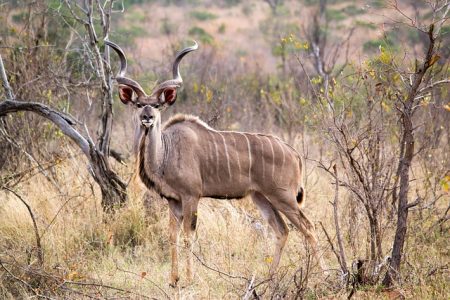 Pin
Pin The Greater Kudu / Photo from pixabay
The Greater Kudu stands as perhaps the most Sculptural of all Antelopes — a creature that seems designed by an Artist who understood that Beauty need not sacrifice Power. The Bulls weigh between 400 and 700 pounds — substantial enough to command Respect — yet they move through the Thorny Scrublands of Eastern and Southern Africa with a Dancer’s precision. What arrests the Eye immediately are the Horns — those magnificent spiraling Towers that can exceed five feet in length and complete two and a half full Rotations before terminating in sharp Points that seem to pierce the very Sky itself.
These Horns do not merely sit upon the Head — they define the entire Being of the Animal. Each twist follows a Mathematical principle so perfect that Architects have studied them — seeking to understand how Nature achieves such Strength through Spiral form. The Kudu’s body wears a coat of grayish-brown adorned with six to ten vertical white Stripes that cascade down the Flanks like frozen Waterfalls. The Bulls develop a fringe of Hair along the Throat and Chest — a Beard of sorts — that announces Maturity and Status within the Herd. They inhabit regions where Water grows scarce and the Sun shows no Mercy — yet the Kudu persists — browsing on Leaves and Shoots — patient as Stone — waiting for the Rains that may or may not arrive. To observe a Bull standing motionless among the Acacia Trees is to see something that belongs equally to the Animal Kingdom and to the realm of living Sculpture.
5. The Waterbuck — Sentinel of the Riverbanks
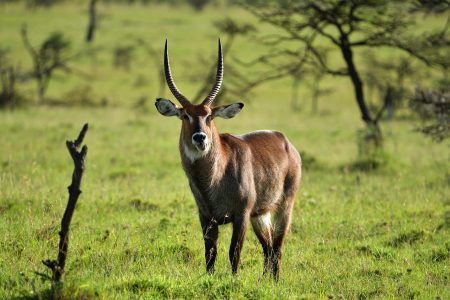 Pin
Pin Waterbuck / Image by xiSerge from Pixabay
The Waterbuck earns its Name not through any particular love of Swimming — but through sheer Necessity and Devotion to the Water’s Edge. These robust Antelopes weigh between 350 and 600 pounds — the Bulls carrying the greater Burden — and they station themselves never far from Rivers, Lakes, and Marshlands across Sub-Saharan Africa. Their coats appear shaggy and coarse — colored in grays and browns that seem almost drab until the Light catches them just so — and then you notice the distinctive white Ring encircling the Rump like a Target painted by Nature herself. This marking serves as Recognition — a Signal to other Waterbuck that says here is Safety — here is Home.
The Bulls possess Horns that sweep upward and slightly forward in graceful Arcs — reaching lengths of thirty inches or more — Weapons and Ornaments both. These Antelopes have developed an unusual Defense against Predators — their Skin secretes an oily Substance with a pungent Odor that many Carnivores find distasteful. It renders their Flesh less appealing — a kind of chemical Diplomacy that allows them to graze in Peace more often than not. They spend their Days in the tall Grasses near Water — emerging at Dawn and Dusk to drink and feed — always vigilant — always aware that the River that gives Life also attracts those who would take it. The Waterbuck understands Balance — lives it daily — and teaches us that Survival often means staying close to what sustains you even when Danger lurks nearby.
6. The Nyala — Elegance Draped in Shadow and Light
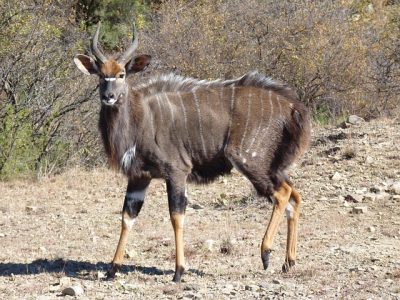 Pin
Pin Nyala / Image by Barbara Fraatz from Pixabay
The Nyala occupies a peculiar Position among Antelopes — neither fully large nor decidedly medium — but possessing such striking Beauty that Size becomes almost irrelevant to its Impact. The Bulls can reach weights of 250 to 280 pounds — modest compared to the Giants we have already encountered — yet their Presence commands Attention in ways that transcend mere Mass. They inhabit the Dense Thickets and Riverine Forests of Southern Africa — places where the Canopy filters Sunlight into a thousand shifting Patterns. The Bulls wear dark chocolate-brown coats marked with up to fourteen thin white Stripes that run vertically down their Sides — each Stripe a brushstroke of Light against Darkness.
What makes the Nyala particularly fascinating is the dramatic Difference between Males and Females — a Dimorphism so pronounced they might seem different Species entirely. The Cows remain a bright rufous color — light and unmarked except for their own delicate Stripes — while the Bulls develop long fringing Hair along their Undersides that forms a kind of Skirt swaying with each Movement. Their Horns spiral in a single gentle Twist — lyre-shaped and reaching twenty-eight inches — elegant rather than imposing. The Nyala teaches us that Beauty operates by its own Mathematics — that Impact need not correlate with Scale — and that sometimes the most memorable Creatures are those who balance Power with Grace so perfectly that we cannot say which Quality dominates. They move through their Territories like Shadows given Form — appearing and vanishing with equal Ease — reminding us that the Forest keeps its own Counsel.
7. The Roan Antelope — The Aristocrat of Grasslands
 Pin
Pin Roan Antelope / Photo from Wikimedia Commons
The Roan Antelope stands as one of Africa’s most stately Creatures — a Being that seems to carry itself with an awareness of its own Significance. These Animals rank among the largest — Bulls weighing between 500 and 650 pounds — and they inhabit the Woodlands and Grasslands that stretch across Central and West Africa. Their Name derives from their distinctive coloring — a reddish-brown or strawberry-roan coat that shifts in Hue depending on the Season and the Quality of Light. The Face bears bold black-and-white Markings — a mask of sorts — with long tufted Ears that stand erect like the Plumes on a Cavalry Officer’s helmet. These Ears can measure ten inches in length — always listening — always aware of the World’s subtle Warnings.
Both Sexes carry Horns that curve backward in strong sweeping Arcs — reaching lengths of thirty inches or more in the Bulls — ridged along their Length like ancient Scripts carved into Bone. The Roan moves with deliberate Purpose across its Territory — never hurried — never careless. They form small Herds led by dominant Cows while the Bulls patrol the Boundaries — defending against Intruders with a Ferocity that belies their generally peaceful Demeanor. What strikes the Observer is their almost Regal bearing — the way they hold their Heads high — the measured Pace of their Walking — as though they understand they represent something Important in the grand Architecture of the Savanna. The Roan teaches us that Dignity is not bestowed but cultivated — that Presence comes not from Size alone but from the way one inhabits one’s own Existence with complete Conviction.
8. The Sable Antelope — Darkness Crowned with Crescents
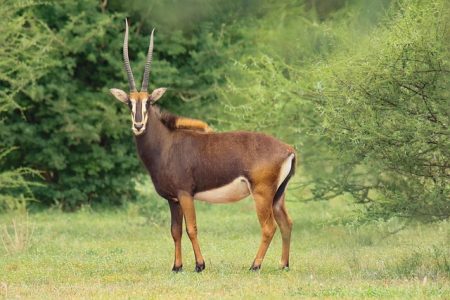 Pin
Pin Sable Antelope / Image by Josiane Boute from Pixabay
The Sable Antelope shares Lineage with the Roan — yet it chose a different Path entirely in matters of Appearance and Temperament. The Bulls wear coats of such deep black they seem to absorb Light itself — a Darkness interrupted only by white Markings on the Face and Belly that create stark Contrast like Snow on Midnight. The Cows and younger Animals maintain a rich chestnut color — but as the Bulls mature — they darken progressively until they achieve that glossy ebony Sheen that makes them unmistakable. These Animals weigh between 400 and 600 pounds — substantial but built for Speed and Agility rather than pure Mass. They inhabit the Miombo Woodlands of Southern Africa — regions where the Trees grow in particular Formations and the Grasses reach Heights that provide both Cover and Sustenance.
The Horns of the Sable deserve special Consideration — for they represent perhaps the most dramatic Weaponry in the entire Antelope Family. Sweeping backward in magnificent Crescents — they can exceed five feet in length in exceptional Bulls — each one ridged with Rings that mark the Years like Growth Rings in Trees. These are not mere Ornaments but functional Instruments of Defense — and a Sable Bull cornered by Predators has been known to fight Lions to a Standstill or even kill them outright. The Sable possesses something the Roan does not — a certain Defiance — an unwillingness to yield Ground even when Prudence might suggest Retreat. They stand as Reminders that Beauty and Ferocity often share the same Form — that the darkest Coats may house the brightest Spirits — and that Survival sometimes demands we bare our Teeth at the Things that would consume us.
9. The Gemsbok — Desert's Defiant Blade-Bearer
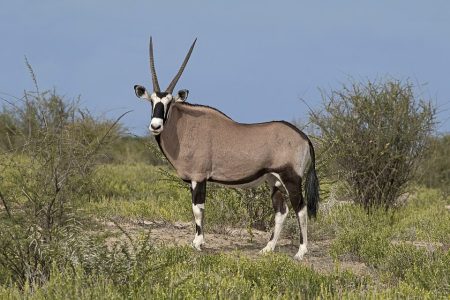 Pin
Pin Gemsbok Antelope / Photo from Wikimedia Commons
The Gemsbok — also called the Oryx — inhabits Places where most living Things would perish within Days. This Antelope has mastered the Art of existing in the Kalahari and Namib Deserts — regions where Temperatures soar beyond what seems endurable and Water exists more as Concept than Reality. They weigh between 400 and 500 pounds — both Bulls and Cows nearly equal in Size — and their bodies have been refined by Evolution into perfect Instruments for Desert Survival. The coat displays a pale gray-fawn color with bold black Markings on the Face, Flanks, and Legs — a pattern so striking it seems almost deliberately painted. These contrasting Colors serve a Purpose beyond Aesthetics — they help regulate Body Temperature by reflecting the Sun’s merciless Rays.
The Horns of the Gemsbok rank among Nature’s most lethal Designs — perfectly straight Rapiers that can exceed forty inches in Length and taper to Points sharp enough to pierce Hide and Bone. Both Sexes carry these Weapons — though the Cows’ Horns often grow longer and more slender than those of the Bulls. The Gemsbok has developed remarkable Adaptations to Desert Life — they can allow their Body Temperature to rise significantly during the Day — storing Heat rather than expending precious Water to cool themselves — then radiating that Heat away during the cold Desert Nights. They extract Moisture from the Plants they consume and can survive indefinitely without drinking if necessary. This Antelope teaches us that Life persists not through abundance but through Ingenuity — that the harshest Environments forge the most resilient Spirits — and that sometimes Survival means becoming so efficient at existing that the Impossible becomes merely Difficult.
10. The Addax — Ghost of the Sahara's Forgotten Reaches
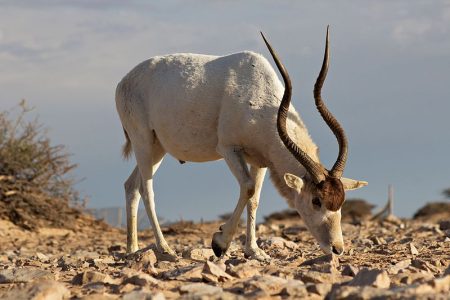 Pin
Pin Addax Antelope / Photo from Wikimedia Commons
The Addax represents something almost mythical — an Antelope so adapted to extreme Desert Life that it exists on the very Edge of what Biology allows. These pale Creatures weigh between 130 and 280 pounds — smaller than many on our List — yet they earn their Place through sheer Determination and the spectacular Horns both Sexes possess. Those Horns spiral upward in two or three elegant Twists — reaching lengths of forty inches in the Bulls — creating a Corkscrew pattern so perfect it seems intentional rather than organic. The Addax once roamed the entire Sahara Desert — that vast Ocean of Sand where Temperatures swing from scorching Days to freezing Nights — but now they teeter on Extinction’s precipice with fewer than one hundred remaining in the Wild.
Their coat changes with the Seasons — sandy blonde in Summer to grayish-brown in Winter — always providing Camouflage against the shifting Dunes. The Addax has evolved broad Hooves that spread wide like natural Snowshoes — preventing them from sinking into the soft Sand as they traverse their waterless Domain. They can survive their entire Lives without drinking — obtaining all necessary Moisture from the sparse Desert Vegetation they consume. What haunts the Observer is how few remain — how close we came to losing them entirely to Hunting and Habitat Loss — how something so perfectly designed for Survival now survives primarily in protected Reserves and Zoos. The Addax reminds us that Adaptation — no matter how elegant — cannot shield a Species from Human Impact — that Rarity and Beauty together cannot guarantee Tomorrow — and that sometimes the most specialized Creatures are also the most vulnerable when their World changes too quickly.
FAQs
The Giant Eland holds this distinction without contest — Bulls reaching 2,200 pounds and standing six feet at the shoulder make them the undisputed champions of Antelope magnitude.
It varies by Species — the Bongo, Gemsbok, and Addax grant Horns to both Sexes, while others like the Kudu reserve this Ornament exclusively for Bulls. Nature plays no favorites consistently.
Those vertical white Lines serve as Camouflage — breaking up the Animal’s Outline in dappled Forest Light or tall Grasses, turning something visible into something that vanishes before the Eye.
Indeed they can — the Eland, despite weighing a Ton, can sprint at speeds exceeding forty miles per hour when Danger demands it. Mass need not mean Slowness when Survival requires Speed.
The Addax stands closest to Oblivion’s edge — fewer than one hundred remain in Wild habitats. The Giant Eland and Bongo also face considerable Threats from Habitat Loss and Hunting pressures.
